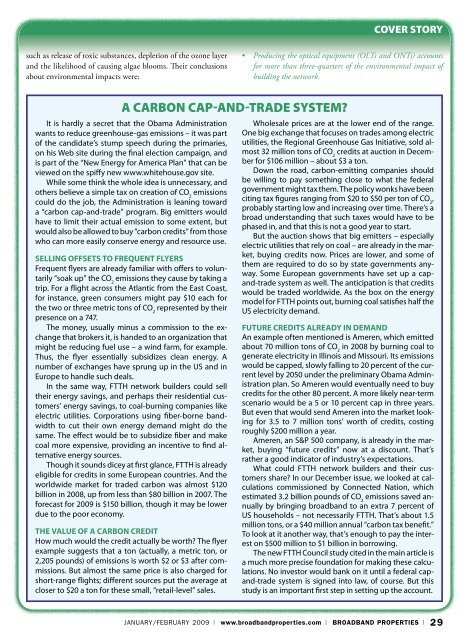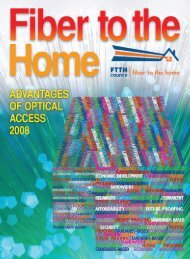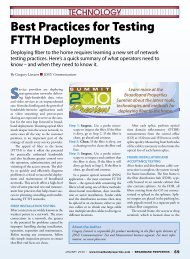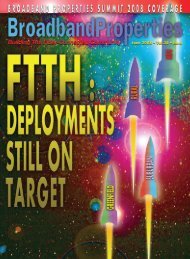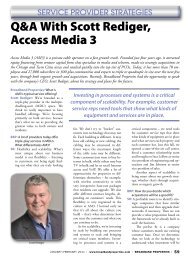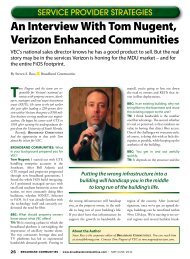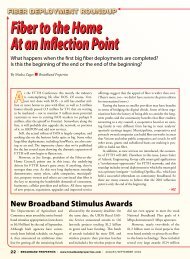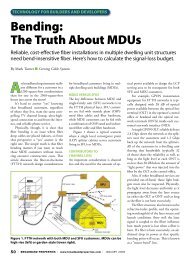bbpmag.com - Broadband Properties
bbpmag.com - Broadband Properties
bbpmag.com - Broadband Properties
Create successful ePaper yourself
Turn your PDF publications into a flip-book with our unique Google optimized e-Paper software.
cover story<br />
such as release of toxic substances, depletion of the ozone layer<br />
and the likelihood of causing algae blooms. Their conclusions<br />
about environmental impacts were:<br />
• Producing the optical equipment (OLTs and ONTs) accounts<br />
for more than three-quarters of the environmental impact of<br />
building the network.<br />
A Carbon Cap-and-Trade System<br />
It is hardly a secret that the Obama Administration<br />
wants to reduce greenhouse-gas emissions – it was part<br />
of the candidate’s stump speech during the primaries,<br />
on his Web site during the final election campaign, and<br />
is part of the “New Energy for America Plan” that can be<br />
viewed on the spiffy new www.whitehouse.gov site.<br />
While some think the whole idea is unnecessary, and<br />
others believe a simple tax on creation of CO 2<br />
emissions<br />
could do the job, the Administration is leaning toward<br />
a “carbon cap-and-trade” program. Big emitters would<br />
have to limit their actual emission to some extent, but<br />
would also be allowed to buy “carbon credits” from those<br />
who can more easily conserve energy and resource use.<br />
SELLING OFFSETS TO FREQUENT FLYERS<br />
Frequent flyers are already familiar with offers to voluntarily<br />
“soak up” the CO 2<br />
emissions they cause by taking a<br />
trip. For a flight across the Atlantic from the East Coast,<br />
for instance, green consumers might pay $10 each for<br />
the two or three metric tons of CO 2<br />
represented by their<br />
presence on a 747.<br />
The money, usually minus a <strong>com</strong>mission to the exchange<br />
that brokers it, is handed to an organization that<br />
might be reducing fuel use – a wind farm, for example.<br />
Thus, the flyer essentially subsidizes clean energy. A<br />
number of exchanges have sprung up in the US and in<br />
Europe to handle such deals.<br />
In the same way, FTTH network builders could sell<br />
their energy savings, and perhaps their residential customers’<br />
energy savings, to coal-burning <strong>com</strong>panies like<br />
electric utilities. Corporations using fiber-borne bandwidth<br />
to cut their own energy demand might do the<br />
same. The effect would be to subsidize fiber and make<br />
coal more expensive, providing an incentive to find alternative<br />
energy sources.<br />
Though it sounds dicey at first glance, FTTH is already<br />
eligible for credits in some European countries. And the<br />
worldwide market for traded carbon was almost $120<br />
billion in 2008, up from less than $80 billion in 2007. The<br />
forecast for 2009 is $150 billion, though it may be lower<br />
due to the poor economy.<br />
THE VALUE OF A CARBON CREDIT<br />
How much would the credit actually be worth The flyer<br />
example suggests that a ton (actually, a metric ton, or<br />
2,205 pounds) of emissions is worth $2 or $3 after <strong>com</strong>missions.<br />
But almost the same price is also charged for<br />
short-range flights; different sources put the average at<br />
closer to $20 a ton for these small, “retail-level” sales.<br />
Wholesale prices are at the lower end of the range.<br />
One big exchange that focuses on trades among electric<br />
utilities, the Regional Greenhouse Gas Initiative, sold almost<br />
32 million tons of CO 2<br />
credits at auction in December<br />
for $106 million – about $3 a ton.<br />
Down the road, carbon-emitting <strong>com</strong>panies should<br />
be willing to pay something close to what the federal<br />
government might tax them. The policy wonks have been<br />
citing tax figures ranging from $20 to $50 per ton of CO 2<br />
,<br />
probably starting low and increasing over time. There’s a<br />
broad understanding that such taxes would have to be<br />
phased in, and that this is not a good year to start.<br />
But the auction shows that big emitters – especially<br />
electric utilities that rely on coal – are already in the market,<br />
buying credits now. Prices are lower, and some of<br />
them are required to do so by state governments anyway.<br />
Some European governments have set up a capand-trade<br />
system as well. The anticipation is that credits<br />
would be traded worldwide. As the box on the energy<br />
model for FTTH points out, burning coal satisfies half the<br />
US electricity demand.<br />
FUTURE CREDITS ALREADY IN DEMAND<br />
An example often mentioned is Ameren, which emitted<br />
about 70 million tons of CO 2<br />
in 2008 by burning coal to<br />
generate electricity in Illinois and Missouri. Its emissions<br />
would be capped, slowly falling to 20 percent of the current<br />
level by 2050 under the preliminary Obama Administration<br />
plan. So Ameren would eventually need to buy<br />
credits for the other 80 percent. A more likely near-term<br />
scenario would be a 5 or 10 percent cap in three years.<br />
But even that would send Ameren into the market looking<br />
for 3.5 to 7 million tons’ worth of credits, costing<br />
roughly $200 million a year.<br />
Ameren, an S&P 500 <strong>com</strong>pany, is already in the market,<br />
buying “future credits” now at a discount. That’s<br />
rather a good indicator of industry’s expectations.<br />
What could FTTH network builders and their customers<br />
share In our December issue, we looked at calculations<br />
<strong>com</strong>missioned by Connected Nation, which<br />
estimated 3.2 billion pounds of CO 2<br />
emissions saved annually<br />
by bringing broadband to an extra 7 percent of<br />
US households – not necessarily FTTH. That’s about 1.5<br />
million tons, or a $40 million annual “carbon tax benefit.”<br />
To look at it another way, that’s enough to pay the interest<br />
on $500 million to $1 billion in borrowing.<br />
The new FTTH Council study cited in the main article is<br />
a much more precise foundation for making these calculations.<br />
No investor would bank on it until a federal capand-trade<br />
system is signed into law, of course. But this<br />
study is an important first step in setting up the account.<br />
January/February 2009 | www.broadbandproperties.<strong>com</strong> | BROADBAND PROPERTIES | 29


